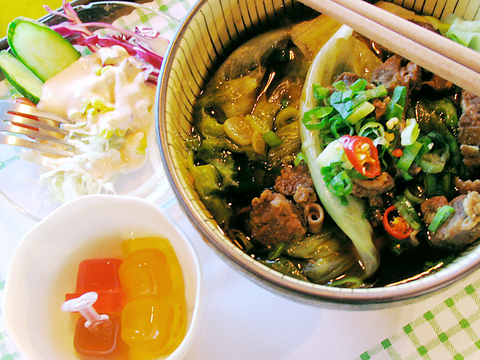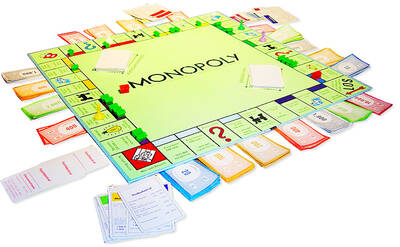Dragonfly is first and foremost a studio specializing in glass-bead artwork. It was founded 22 years ago as a means to employ local Paiwan Aboriginal women and to ensure that their centuries-old tradition of making and wearing glass beads could be brought to a larger cultural stage.
Not long after it opened its doors, though, the need among clients for a convenient place to eat became apparent and the artisans Dragonfly employed to make beads discovered another skill: cooking.
Of course this was no real discovery. "Before [Dragonfly] was a business, and long before we started getting clients to come, we would take turns cooking in the small kitchen in the back," one of the artisan-cum-cooks, Padagow (

PHOTO: DAVID MOMPHARD, TAIPEI TIMES
"We all were taught by our mothers how to make traditional Paiwan dishes," she said.
Now Dragonfly is known almost as well for its pork chops fried on a slab of slate rock as it is for the beautiful glass beads it forges. There are also a variety of noodles on offer, with Dragonfly's beef noodles a favorite among the artisans of the studio.
"We're all Paiwan Aboriginals, but if every day we had the same traditional Paiwan dishes, we'd quickly become tired of them," Padagow said.
She said all the dishes on the limited menu run on the spicy side, but that any can be made less spicy as all the dishes are made fresh.
"We concentrate on making glass beads," Padagow said.
"We haven't put much thought into Dragonfly being a restaurant. We just keep on hand all the supplies necessary to make these few things and, when someone orders something, one of us will turn off our torch for a while and go make it," she said.
For not having put much thought into the restaurant, Dragonfly has some of the nicest ambiance you'll find at any eatery. This is, of course, thanks to the hundreds of thousands of beads that decorate the ceiling, the floor and the antique furnishings.
"We have a theory," Padagow said, "that everyone who comes here gets hungry after seeing the beads. They're all very colorful. Some people say they look edible!"

With one week left until election day, the drama is high in the race for the Chinese Nationalist Party (KMT) chair. The race is still potentially wide open between the three frontrunners. The most accurate poll is done by Apollo Survey & Research Co (艾普羅民調公司), which was conducted a week and a half ago with two-thirds of the respondents party members, who are the only ones eligible to vote. For details on the candidates, check the Oct. 4 edition of this column, “A look at the KMT chair candidates” on page 12. The popular frontrunner was 56-year-old Cheng Li-wun (鄭麗文)

“How China Threatens to Force Taiwan Into a Total Blackout” screamed a Wall Street Journal (WSJ) headline last week, yet another of the endless clickbait examples of the energy threat via blockade that doesn’t exist. Since the headline is recycled, I will recycle the rebuttal: once industrial power demand collapses (there’s a blockade so trade is gone, remember?) “a handful of shops and factories could run for months on coal and renewables, as Ko Yun-ling (柯昀伶) and Chao Chia-wei (趙家緯) pointed out in a piece at Taiwan Insight earlier this year.” Sadly, the existence of these facts will not stop the

Oct. 13 to Oct. 19 When ordered to resign from her teaching position in June 1928 due to her husband’s anti-colonial activities, Lin Shih-hao (林氏好) refused to back down. The next day, she still showed up at Tainan Second Preschool, where she was warned that she would be fired if she didn’t comply. Lin continued to ignore the orders and was eventually let go without severance — even losing her pay for that month. Rather than despairing, she found a non-government job and even joined her husband Lu Ping-ting’s (盧丙丁) non-violent resistance and labor rights movements. When the government’s 1931 crackdown

The first Monopoly set I ever owned was the one everyone had — the classic edition with Mr Monopoly on the box. I bought it as a souvenir on holiday in my 30s. Twenty-five years later, I’ve got thousands of boxes stacked away in a warehouse, four Guinness World Records and have made several TV appearances. When Guinness visited my warehouse last year, they spent a whole day counting my collection. By the end, they confirmed I had 4,379 different sets. That was the fourth time I’d broken the record. There are many variants of Monopoly, and countries and businesses are constantly